It’s Fish on Osaka! In this part II (of three articles of Fishing guide in Osaka) we will examine four of eight ‘secret’ locations on the North- Central bay, then in the next installment, part III of three- four more ‘secret’ spots on the South-Central bay! Each LOCATION will contain different POINTS to be fished within each location. Wherein part one was a guide to gear-less beginners, the places arranged within this article and part III will be tackle and gear-specific to terrain, species of fish to target, navigation, access, and the intention of hooking up on medium to large sized fighters!
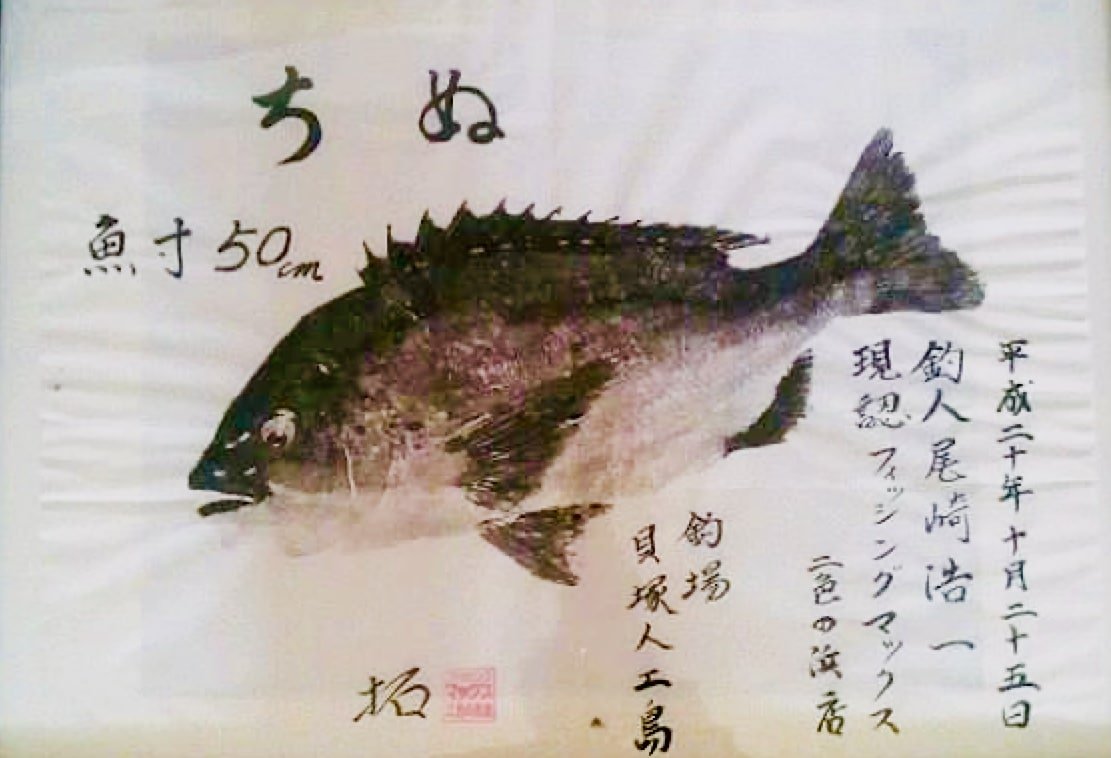
Take note: Locations listed will require you to source your own gear! Each “location” will be the name of the area on the bay/ “points” will be areas within that locale to try. Details will provide a bird’s eye view of what can be caught and where. These locations are the author’s ‘tip of the hat’ faves to veteran anglers —or even to once avid anglers who are eager to get back into the game— here in Osaka Bay’s veritable ‘Fish Garden’. We here at Osaka.com hope to provide explanations and details that help long-timers as well as newcomers to Osaka find access to some frenzy-level sport fishing!
First, let us delve a bit into the Yodo River region and its nutrient rich estuary around which the silts of time have built up a land- raft- peninsula onto the water called the Uemachi Plateau. From there, we will work our way ever southward with each location listed! Enjoy!!
Table of Contents
The Uemachi Plateau’s Backpages
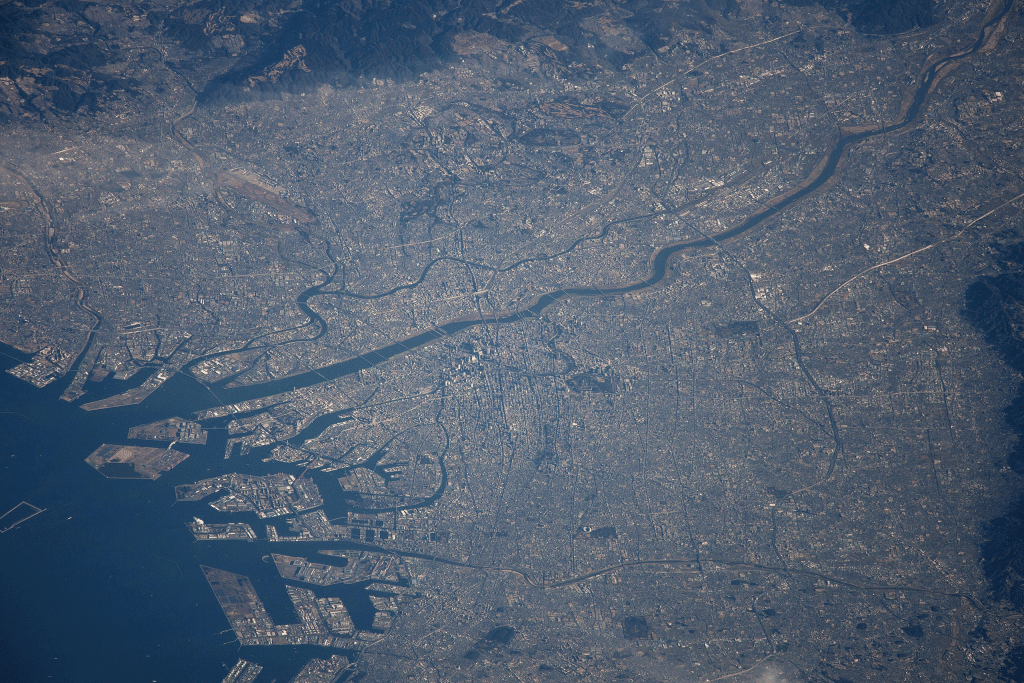
THE GRAND BAY of Naniwa-Osaka. The Fish Garden. The Venice of the Far East. Levees. Canals. Rivers. Open sea. Naniwa. The old name before Osaka was anything more than a small, nondescript village just S.E. of the land upon which Osaka Jo Castle would one day be built.
In Osaka Prefecture alone, three main rivers, the Uji and Katsura rivers (flowing from Kyoto prefecture and Biwa Lake) and the Kizu River (flowing through Mie and Nara prefectures) combine to make the mighty Yodo River. Over many millennia these deposited sand, silt, and soil creating a vast alluvial flood plain forming a great number of sandbars known collectively as Naniwa Nanoshima as well as a peninsula called the Uemachi Plateau: the ground upon which modern day Osaka would one day rise.
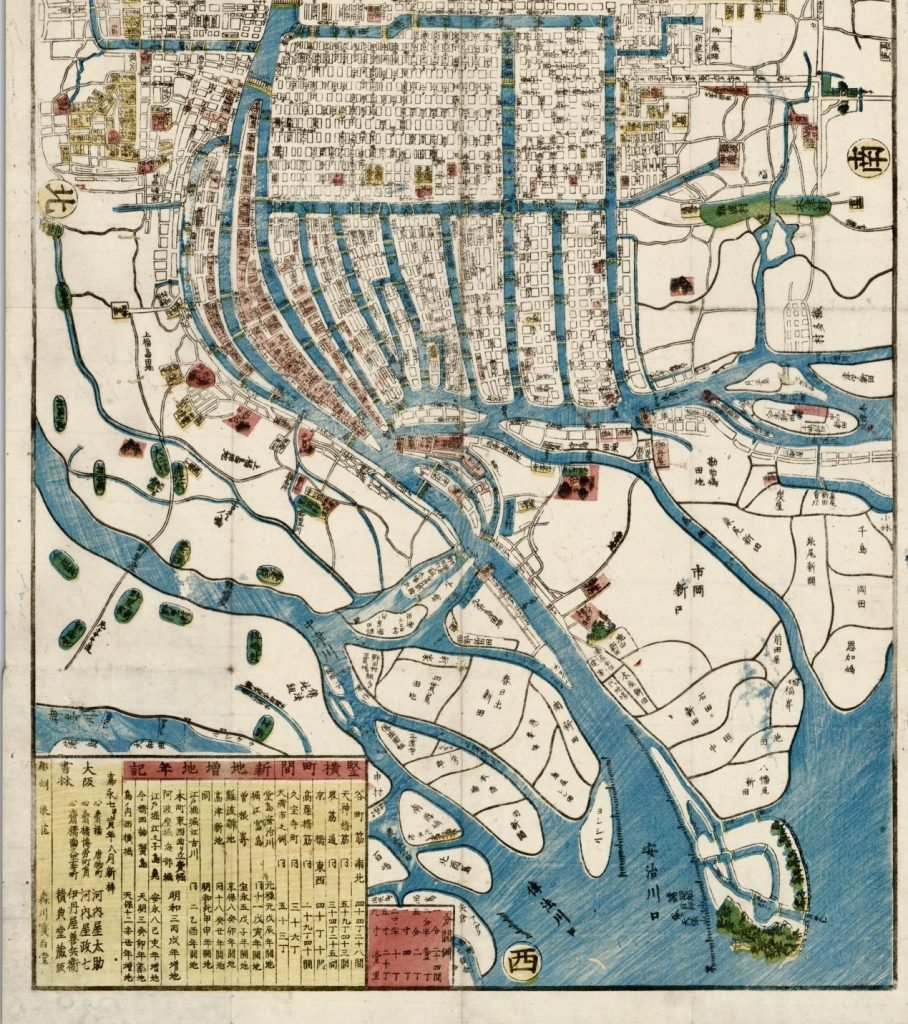
Naniwa-Osaka, Uemachi Plateau formed over millennia as the Yodo River flows into the Osaka Bay. PC:Wikipedia.jp.
In 1603 (Edo Period) the ruling Tokugawa Shogunate brought the city of Naniwa under its direct control. Orders were given to drain the inland sea/lake (modern day Higashi Osaka) via a series of dredged canals. This dredging created levees. These were widened for transport becoming an interconnected web of water ‘streets’. Moats, quays, piles and great piers were further built out on to the bay.
Would-be merchants came from all over Japan to virtually ‘set up shop’. In no time at all her network of waterways would be lined with fish hangars, trade centers, storage warehouses, mercantile shops, and vast piers along which boats would unload their cargo. Commerce began to thrive. And along this course of time…so did fishing for leisure or sport!
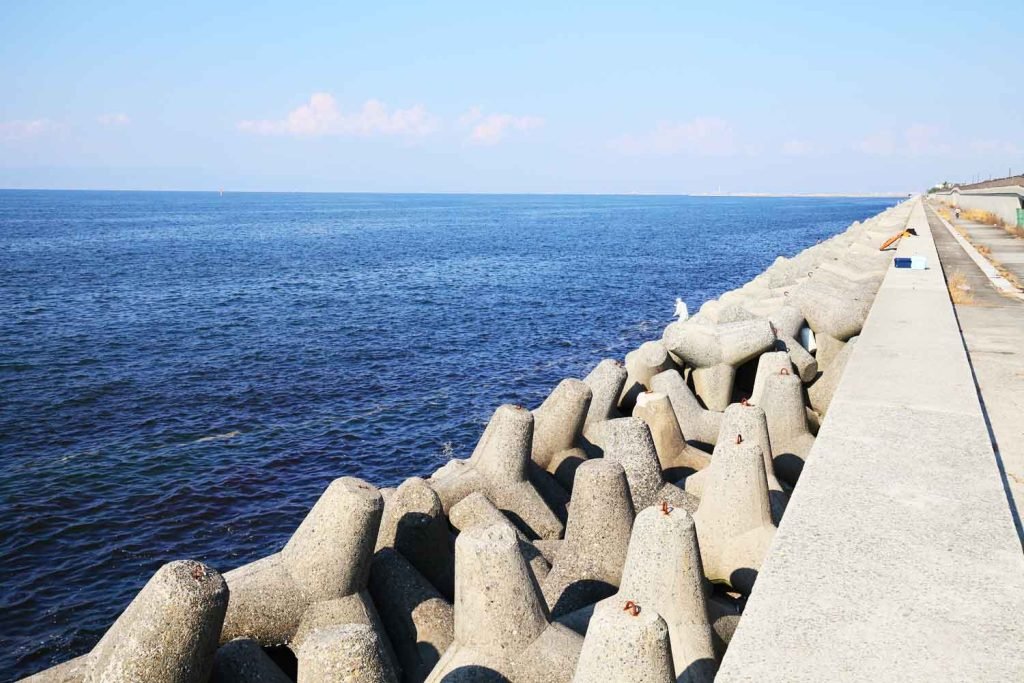
The Meiji Period (1868-1912) saw the construction of large-scale factories built upon concrete islands or extended sandbars. New piers were built up in place of old piers and moats. More landfill islands were constructed with long quays leading far out onto the bay. In the 1940’s and postwar 50’s shoreline fortification became a thing with the utilization of tetrahedron water breaks. In successive years to come this sprawl would reach up and down the coastline of Osaka prefecture, the area we will explore a little more deeply than we delved in Part I.
Fish We Target in this Article
The species of fish that thrive around any abutment on the bay are varied and in abundance. And where there are abundant fish, there tend to be abundant fishers! Osaka has made many places accessible to anglers in hopes of carrying on the tradition of being a city on the water where its citizens can benefit from the treasures her bay still offers.
The following table showcases the game fish we most want to target and which are most abundant. While there a great many species to be had in each locale, the fish shown in the table below will by and large, be our target species. If a species not in this table stands out as a highly probable catch in any location, aka, Spanish Mackerel, or Octopus, etc., it will be mentioned!
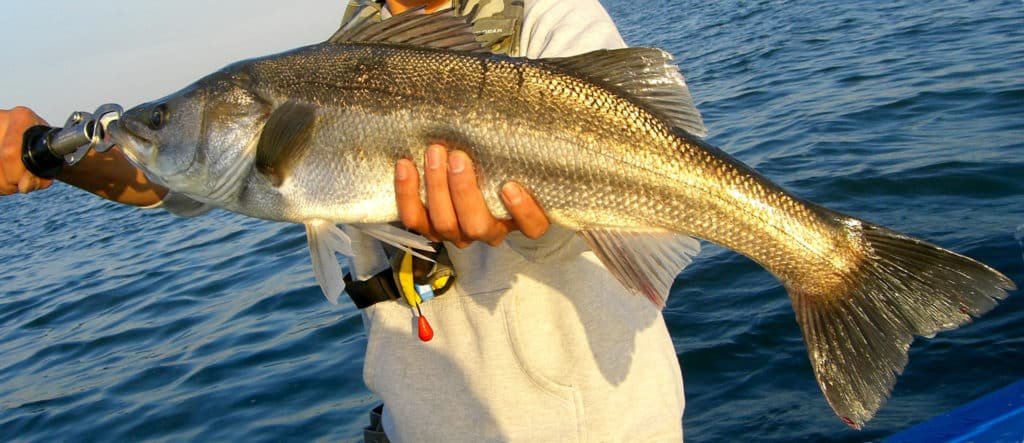
| Target species | Japanese name | Season/ Best time to land fish | Highlights/Takeaways |
| Sea Bass | Tsuzuki | Year round | High probability catch . Large fish available. Lures best! |
| Baby Sea Bass | Hane (40-60cm.) Seigo ( >30cm.) | March- June | High probability catch in the months mentioned. Very good eating! |
| Millet | Kibire | Year round | High probability catch . Large fish available. Lures best! |
| Sea Bream | Kurodai, Chinu Madai | Year round *Best Mar.- Dec. | Medium probability catch. Live bait best! Heavy; need a net. |
| Cutlass Fish | Tachiwou | July~ December | High probability catch. Medium size available. Lures best! |
| Mature Yellowfin/ Mini Tuna | Buri | September~ December | Low probability catch /Good luck!Very Heavy! Net or Gaff needed. Must use strong 12lb test and 60g.+spoon castable 100+m. |
| Young Yellowfin | Hamachi | July~ December | High probability catch. Medium size available. Lures best! |
| Green fish | Aozakana/fuyuburi | July~ December | Medium probability catch. Live bait best! Heavy; need a net. |
| Mahi-Mahi・Dorado | Shira | AugustーDec. | Low Probability from shore but can be had in a top water run oif fishes …best has out on the bay on by boat. however, still within 50m. casting distance form shores. |
| Golden Mackerel/ Horse Mackerel | Ma’aaji Saba | Oct.- December | High probability as young fish are growing in size in these two months. Catch them before they go further out in the bay! Small sizes great as live bait. Big sizes 25-30 cm, best eating! |
| Squid *3 types | Ika | April- June October.-Dec. | *Aori, Surume, and Marui Ika can be had twice a year in spring with the smaller sizes, and again in fall, when they’re bigger in size! |
| Conger Eel | Unagi and Anago – (not a true eel) | June- September | Unagi are fresh water and salt water eels whereas Anago are look alike and are sea water only. Use blood worms or better- as fugu wont steal your bait- fresh garden worms! Low to medium probability catch. |
| Sand fish i.e. Flounder, Halibut, Whiting | Kare, Hirame, Kiss | Two seasons , one in December, One in April. | Both fish listed here are sandy bottom dwellers. In recent years there has been a noticeable decrease in both however you can still catch them! As the bait is the same, if you cant latch onto these, it is possible to land conger eel as well. Dress warm and consult tide guides for tidal conditions. |
A Word of Caution
BE PREPARED: Before fishing these locations or any other, INVEST in some sort of a floatation device or floatable sport fishing vest (floatable and inflatable versions abound.) Falling or being swept into water that is deep with the surface below the revetment or walkway, while not common, it is still very possible with often no means of getting back out easily. WEAR a device! Keep all gear secure, monitor your surroundings, adhere to safety protocol at all times. Have a knotted rope handy in your gear kit.
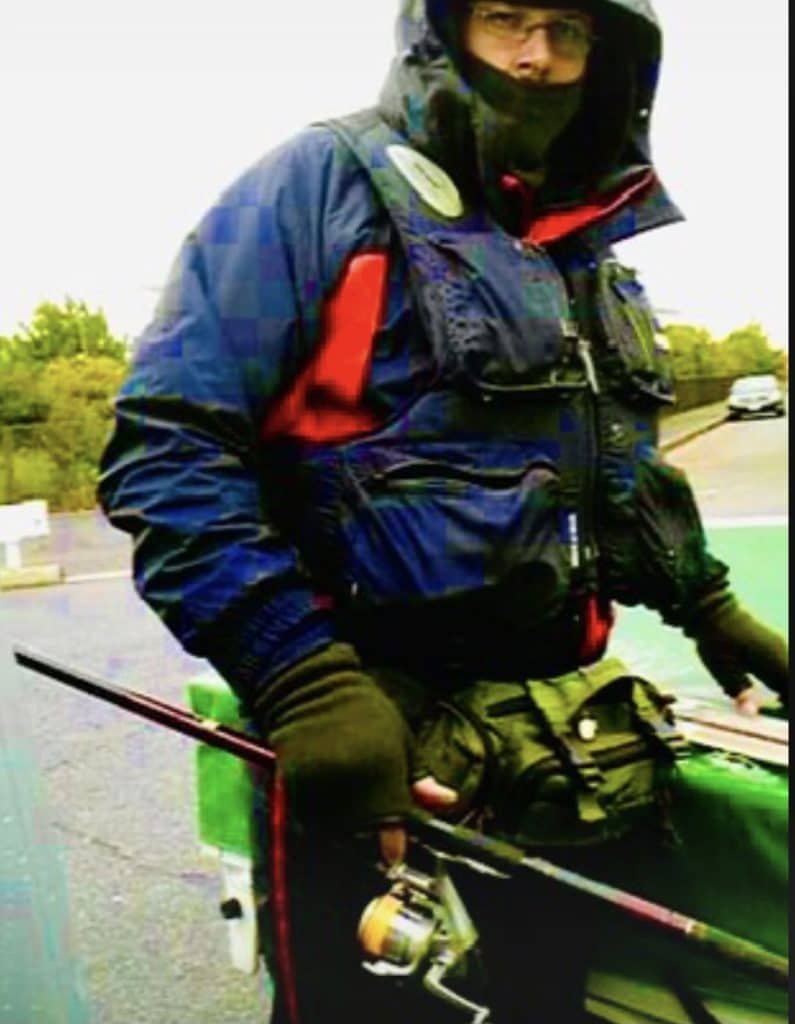
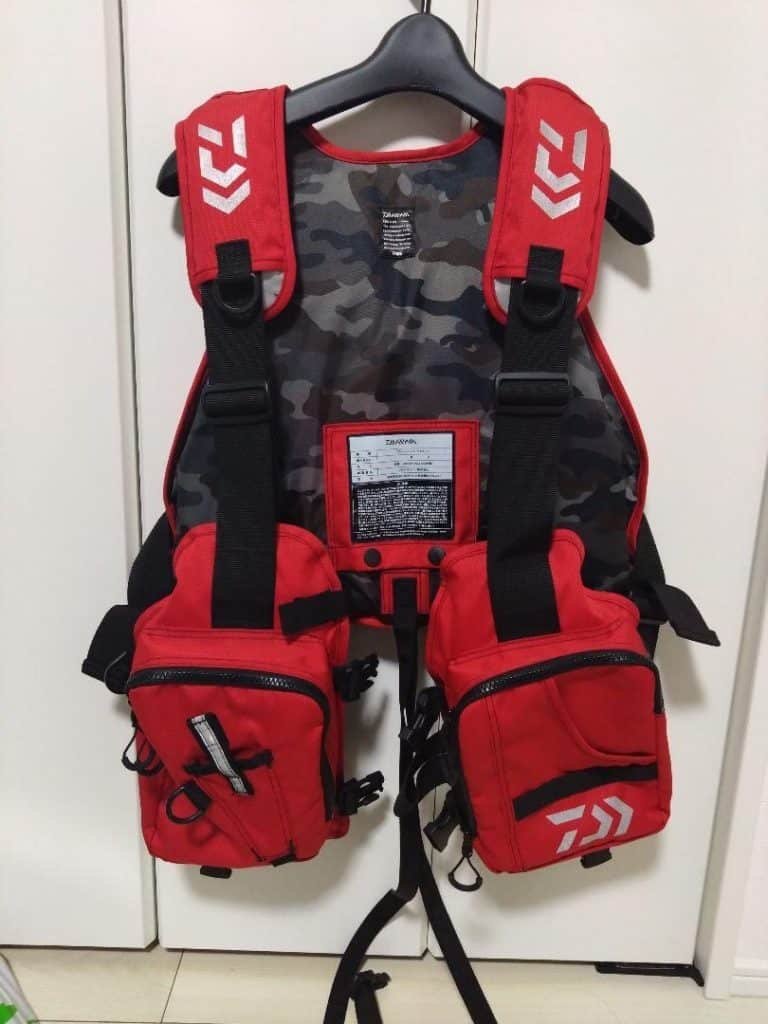
Be prepared to move!! If one spot isn’t hitting, move to another. Be wary of weather changes, especially sudden changes in water level, wave action, storm approaches, and lightening. In the event of lightning, get your rods broken down, stowed, move out BEFORE a storm hits. Often the air becomes suddenly charged with palpable amounts of electricity. Reeling up ‘just a couple more casts’ is akin to reeling/winding a power generator up in your own hands where air is electrically charged. While it is, in reality, only static electricity, it is uncomfortable and can indicate the greater danger of imminent lightening in the immediate area. Get OFF the water, hunker down, wait for the storm to pass.

Location #1: YODOGAWA GUCHI/ Yodo River Mouth
Point # 1: Tsuneyoshi Bridge Area
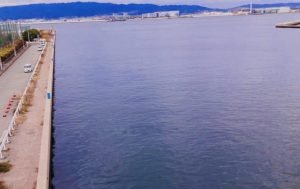
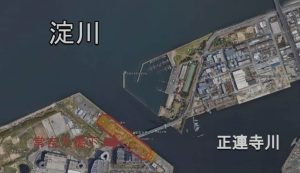
Though there are several points along the Yoda river and after-bay area to fish, we will mention three points that stand out for getting started around the mouth of the Yoda. For various points at the mouth of the bay and up the river as far as Moriguchi see link: turihiroba.com/turiba4/bassyodogawa.html for plenty of information and spots. One point to keep in mind : If fishing up stream (along the river from the mouth moving eastward inside the river stream, upon entering the estuary) it is the left bank (north and west side) that hold media-frenzy-level spots for fishing for large, deep water fish, especially sea bass! The right side of the river however, with less depth, (south and east) has many smaller estuaries and side rivers known to hold vast quantities of smaller to mid sized fish.
NOTE: Many top brand sponsored fishing programs have been filmed up and down both sides of the Yodo River. A plethora of meter-class Tsuzuki-sea bass- abound as well as other species able to thrive in brackish water (that water most often found in estuaries wherein salt water mixes with freshwater.) Kibire- Millet, and Korodai- Black Sea Bream are two more large fish species that are abundant in Yodogawa. Always a fun catch, your target should be any of these three. Light tackle and natural bait or lures such as rubber grub worms, top water poppers that splash atop the surface, deeper water metal or lead headed jigs that bounce along the sea floors and spoon lures imitating swimming fish are your best bet.
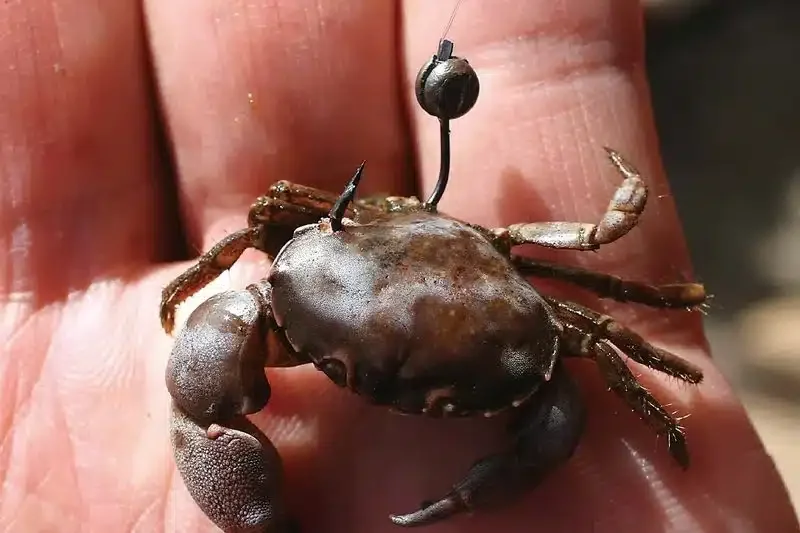
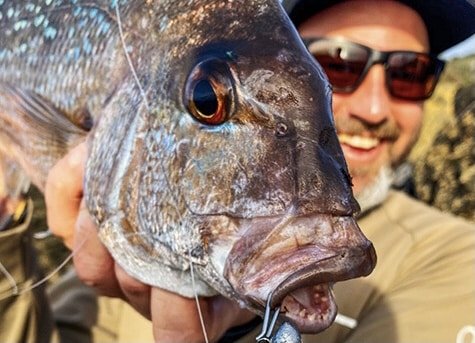
Details:
Located on the north side promenade of Maishima Island.
Private vehicle a must. Cars can be parked free along the road next to the promenade.
Tsuneyoshi bridge connects Osaka Hakko Island with Maishima Island.
Prime fishing spot, flat, concrete revetment, easy access.
Located on the North-side Maishima Promenade, 370m. long , a “Fishing Open Area”.
3 -15m high and 2m. from surface water. Possession of a telescopic net is a must.
6-8 ft. (1.83-2.44m.) egging or bass rod with 3lb. test or higher recommended.
P-line or threaded squid line is your best bet , see local fishing shop for details.
Live bait or lures recommended.
Meter class sea bass, millet, Chinu or black Sea Bream
Point#2: Osaka-Denpo Station Area.
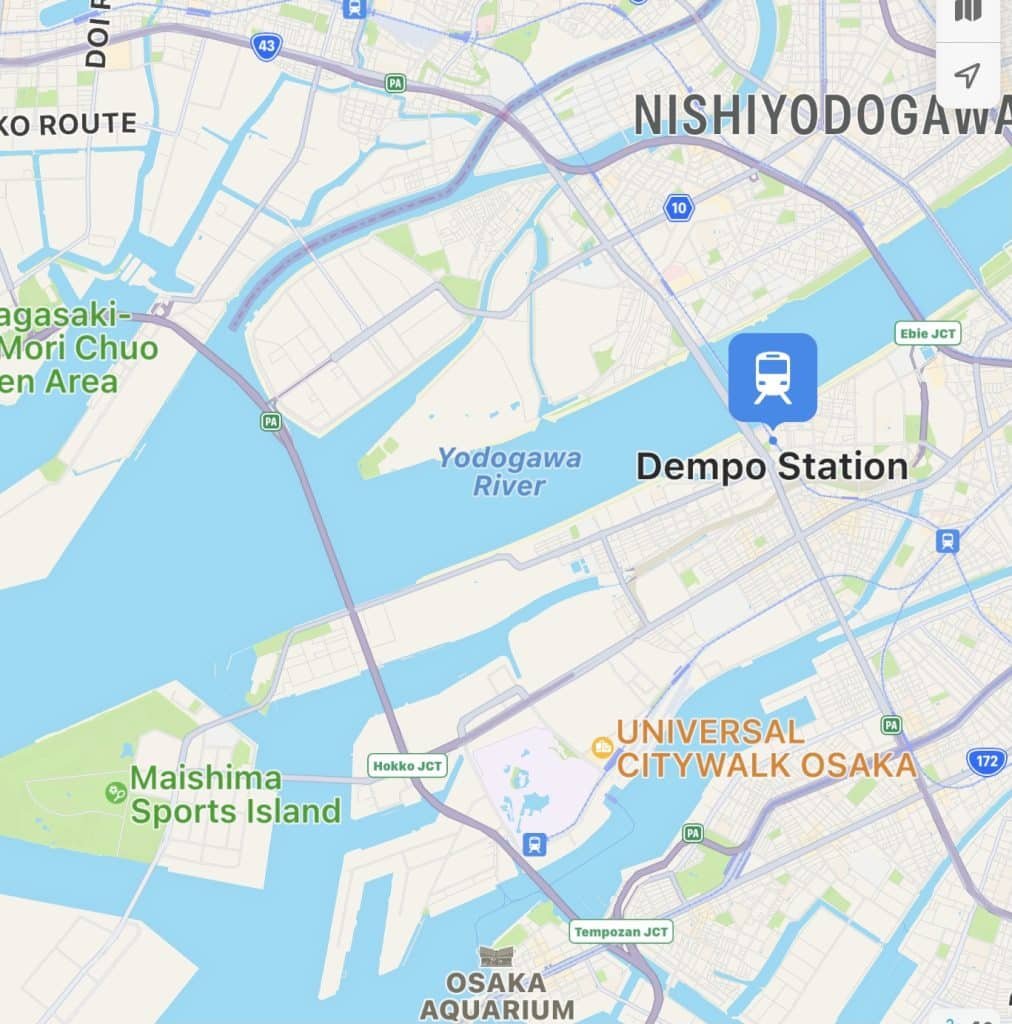
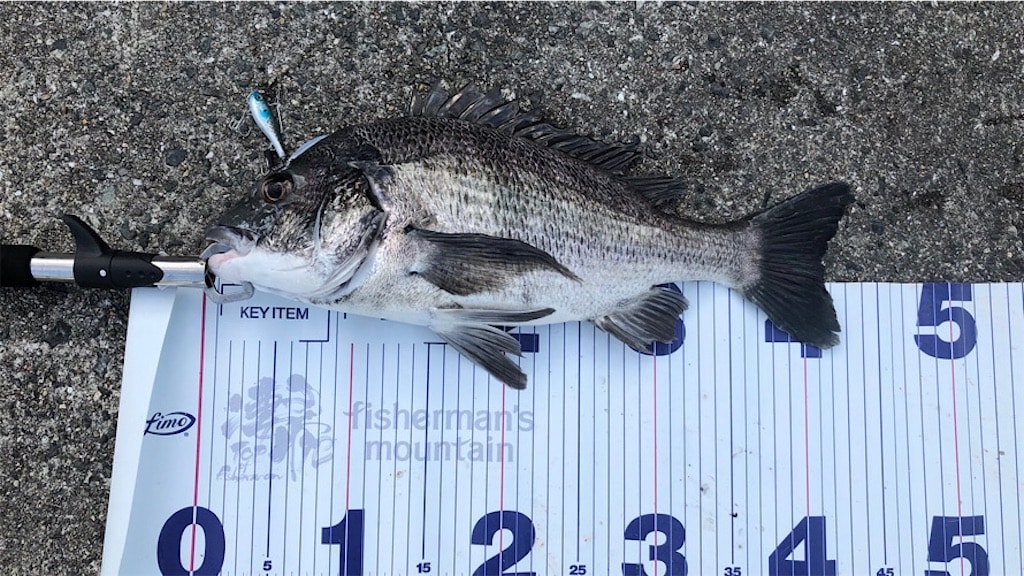
We mentioned above that our target fish are mainly sea bass, millet, black sea bream, also known as Chinu. Though caught year round, the true season on any of these three fish are May – December. I myself like to focus on the autumn season when large migrations of sardines and other bait fish come in as far as the mouth of the Yodogawa. Large size bass come in as well to prey on them. Aim for between 20-50m. off shore from the bank as this is where the stony embankments of the break water drop off to deeper depths. If ever the waters here are boiling, throw on a weighted minnow and rope yourself a doozy! Fish on!
DETAILS:
Pay parking available, easy to access by train.
Promenade is a short ten minute walk to water.
River side access with bank fortified tetrahedron action.
Lure fishing mostly recommended as one can cast more than 100 m. off shore for big fish.
Play the break water with lighter tackle. Millet is a brackish water resident and is in abundance here.
Meter-class sea bass can be had just 50m. offshore.
Cast minnow spoons of 26 oz. in blue and silver to reach the depths for sea bass or yellowfin.
Telescopic net on hand and a hand held gill grip tool to retrieve heavy fish from the water recommended.
This is a great first place to start on the mouth of the Yodo River.
6-8 ft. (1.83-2.44m.) egging or bass rod with 3lb. test or higher recommended. P-line or threaded squid line is your best bet , see local fishing shop for details.
Baitfish or baitfish like lures are recommended.
Point#3: Yagura-Ryokuchi Park Area:
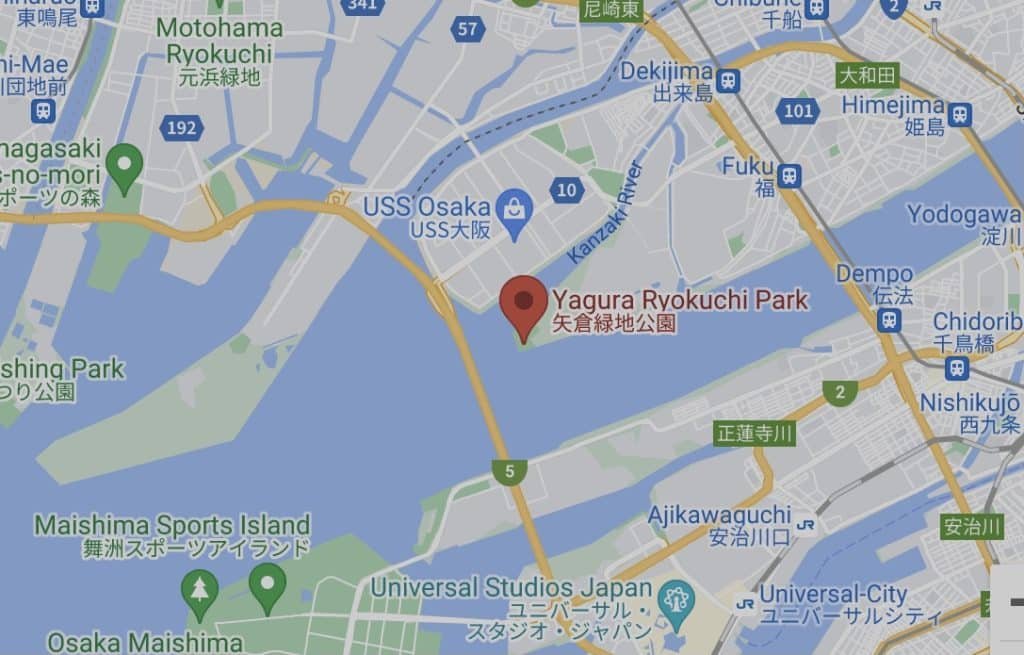
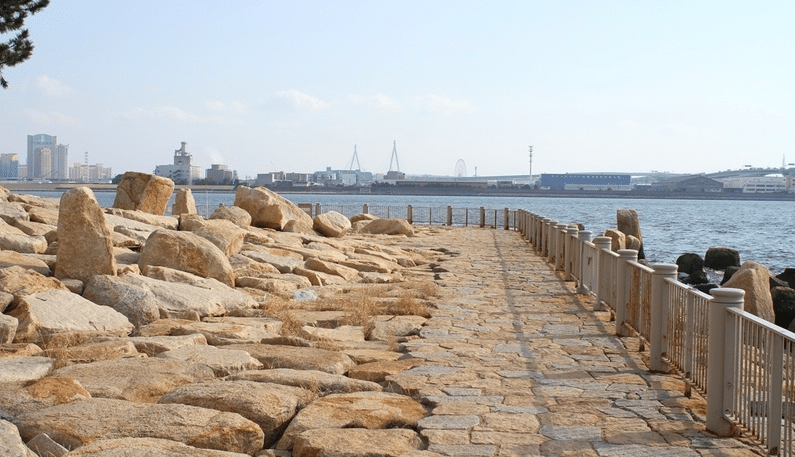
Upstream from the mouth is the third secret spot worth mentioning. This is a large scale artificial park where stone landings and adjoining walkways as well as tide pools and decorative rock formations are placed. Nature meets manmade areas with access to the shoreline for angling, birdwatching, and walking/ jogging.
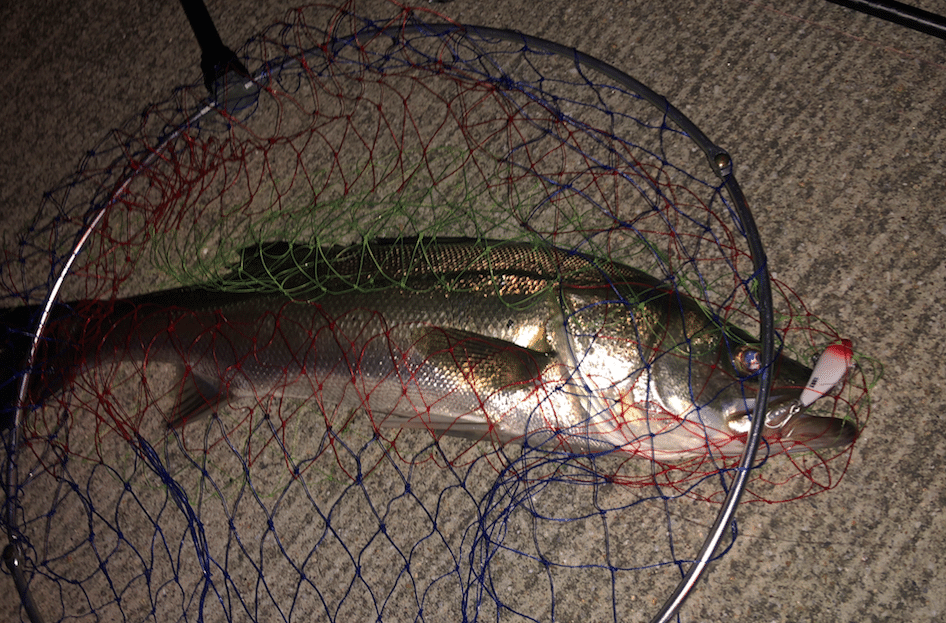
When we say ‘Secret’, we mean these are new to YOU! Plenty of veteran Osaka anglers have long known the ‘secret spots’ that the rest of the world doesn’t know about… secrets don’t last long however amongst anglers in the know. And this spot is a favorite for many of the lure carrying crowd! A park with parking there, step across the cobblestone jetty and marshy promenade to water! The right (North side from the mouth as you make your way upstream) is characterized by abundant nutrition and lots of baitfish as it is a brackish water area. This translates to Sakana no Hoko, or ‘Treasure trove of fish’!
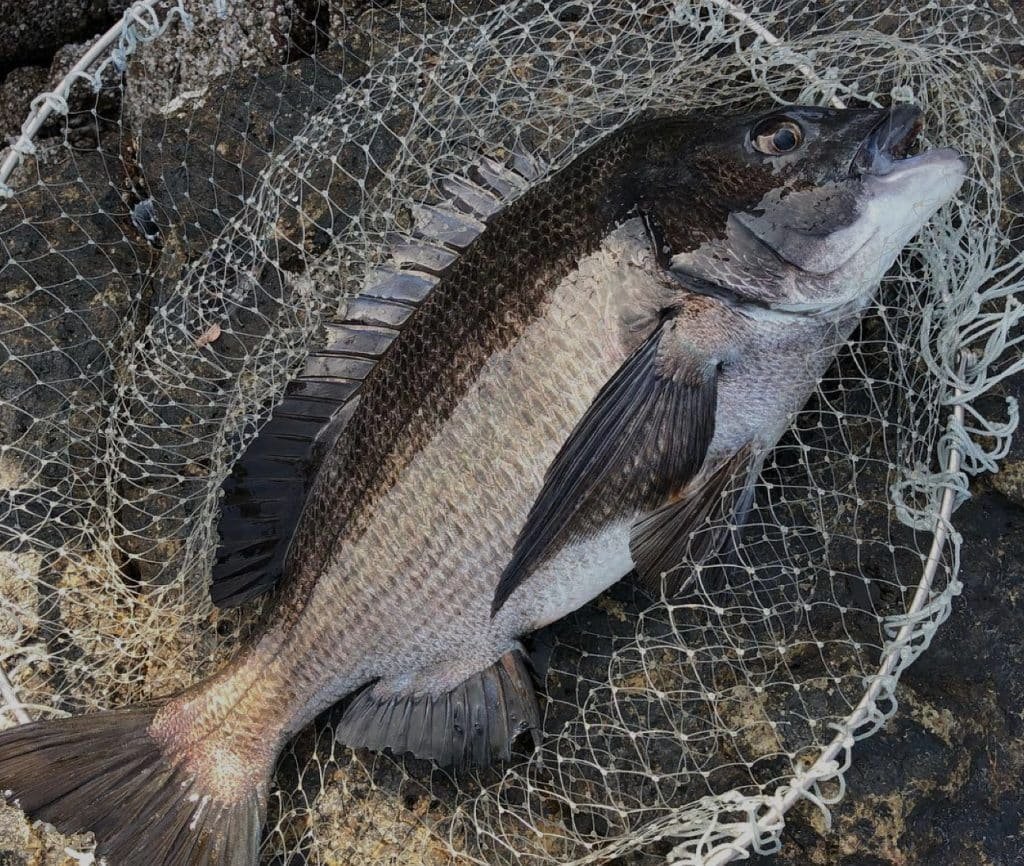
DETAILS:
Yagura-Ryokuchi Park located on the right side or north side of river.
Fantastic stretch of estuary, cobblestone jetties every 100 meters.
Brackish (salt /fresh) water, abundant fish, lots of natural cover, food supply, etc.
Large commuter fish feed mostly on smaller fish within northern estuary.
March~May, small fish increase, so then do medium to big sized fish.
May ~ Nov the warmer months hatches of Inakko and Haku attract preying fish.
Autumn (Sept.~ Nov. end) is prime time. Lots of migrating baitfish— large fish come to prey.
6-8 ft. (1.83-2.44m.) egging or bass rod with 3lb. test or higher recommended. P-line or threaded squid line is your best bet , see local fishing shop for details.
Baitfish or baitfish like lures are recommended.
Obtain a TIDE GUIDE. Big Sea bass and Millet enter the river as the tide is coming up, they go out with the tide. Low tide too, the water surface is too far from shore to cast to.
Aiming for activity at high tide is greatest during evening to night time – especially with regard to river fishing.
Rising waters at high tide; jetties are covered in certain areas.
Various points can be found up or downstream with fantastic fishing!
Keep moving. Hit each point in turn; each can be fished one after another!
Bikes recommended. Pay parking more than 20 min. away on foot.
30 min. walk from FUKU Station on the Hanshin Namba Line.
Hand washing facilities and toilets available.
No convenience stores nor vending machines in the park. Procure your own goods before hitting this location!
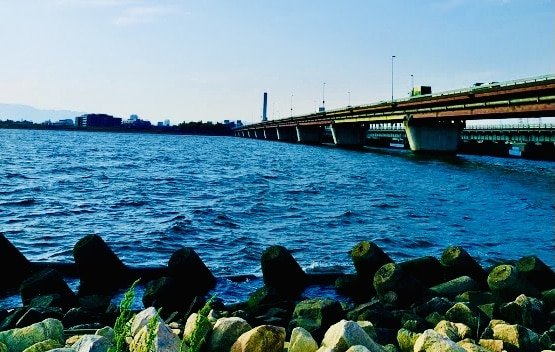
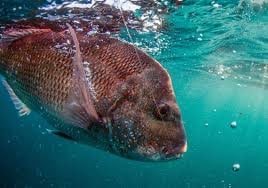
Location #2: Nanko Manmade landfill deep water spots
Point #1: Kamome Ohashi

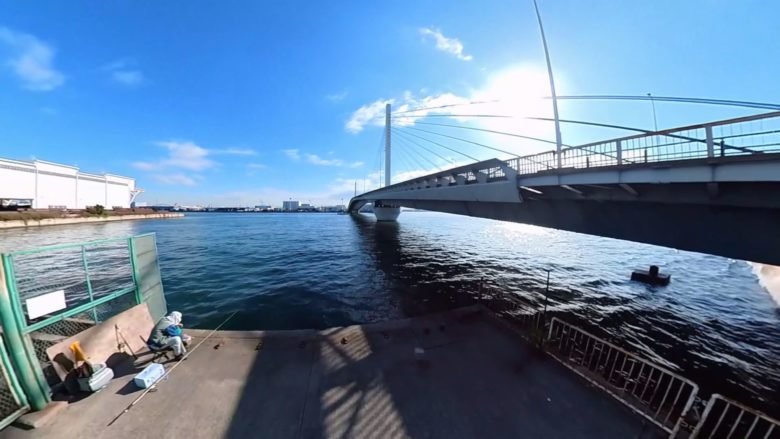
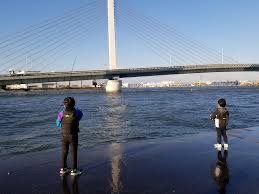
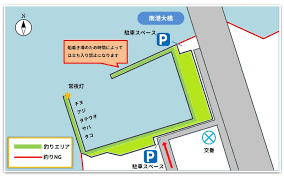
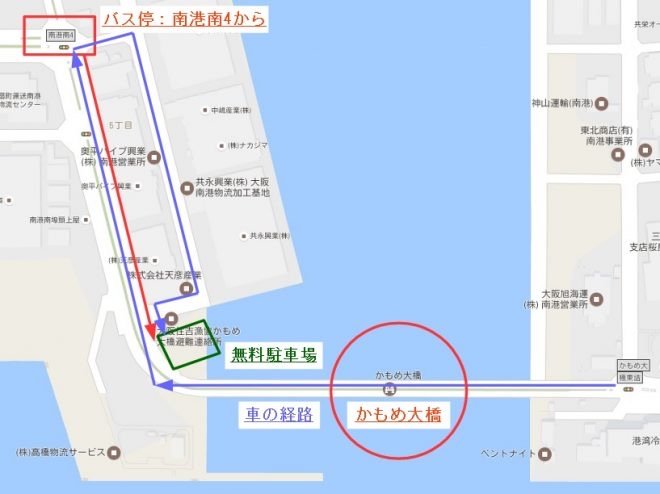
All types of fish (small fish abound as well such as sardines, on our target list above)
Main target are migratory fish, such as Sea bass, Buri, Cutlass fish and more.
A fabulous spot that showcases near explosive fishing in season.
USE SMALL FISH TO CATCH BIG FISH; land smaller fish to use as live bait to catch bigger fish!
Use a multi hook leader line with a weight or mini chum bucket at the bottom. Hook up on live fish and place them in a percolated water environment such as a cooler box.
6-8 ft. (1.83-2.44m.) egging or bass rod with 3lb. test or higher recommended for lure fishing. P-line or threaded Squid line is your best bet. See local fishing shop for details.
Bait fishing is best done with an 8-13 ft. ( 2.44- 3.96m.) seafaring telescopic rod, flexible for casting and fighting fish at medium depths with 6-8 lb. monofilament line or higher. See your local fishing shop for deals.
Use live Aji, Spanish Mackerel and Iwashi, sardines as the perfect live bait for the *barracuda -like Tachiuwou, cutlass fish.
Downside: No Parking/No facilities.
A bike/ moped with gear strapped is used most by locals as there is no car parking.
Can trek 30 min from nearest station to get on water. A hand cart or mini dolly with cooler and rods strapped is recommended if on foot.
Nearest train station : Nanko Higashi Station on the Osaka Metro Nanko Port Line.
Local Map reference: nearest IC point Expressway #4 Wangon Route: NANKO NAKA EXIT.

BEWARE:
Do NOT get your fingers caught in a cutlass fish’s mouth/ teeth. It might be ground to mince in seconds flat or you may loose the finger altogether. Stay vigilant around these! Keep a mini set of metal tooth tongs handy in your kit. Hold the head and jaws in the tongs to remove the hook. Cutlass also have a whiplash effect and their outside spines are razor sharp! Lie the lead line, rig, and fish down onto the ground, gingerly step on the fish to stop movement, use the tongs to grasp the head, (Some fishers will break the neck at this point or will cut through the back head area to instantly render the fish lifeless) remove the hook, place the fish in your fish compartment and resume fishing.
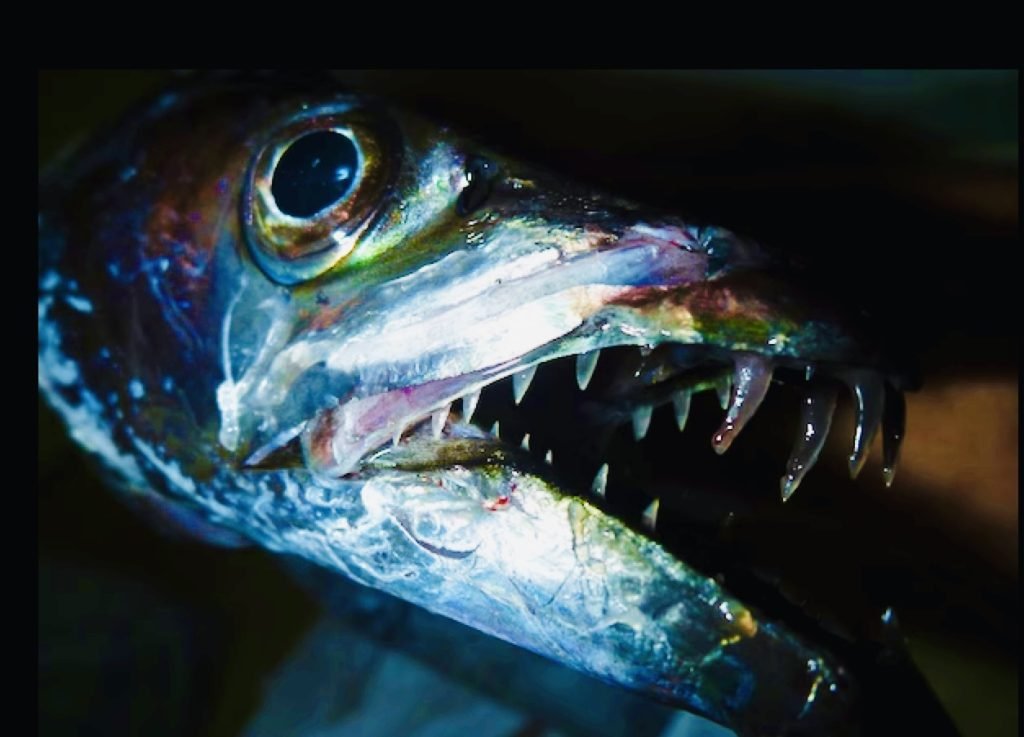
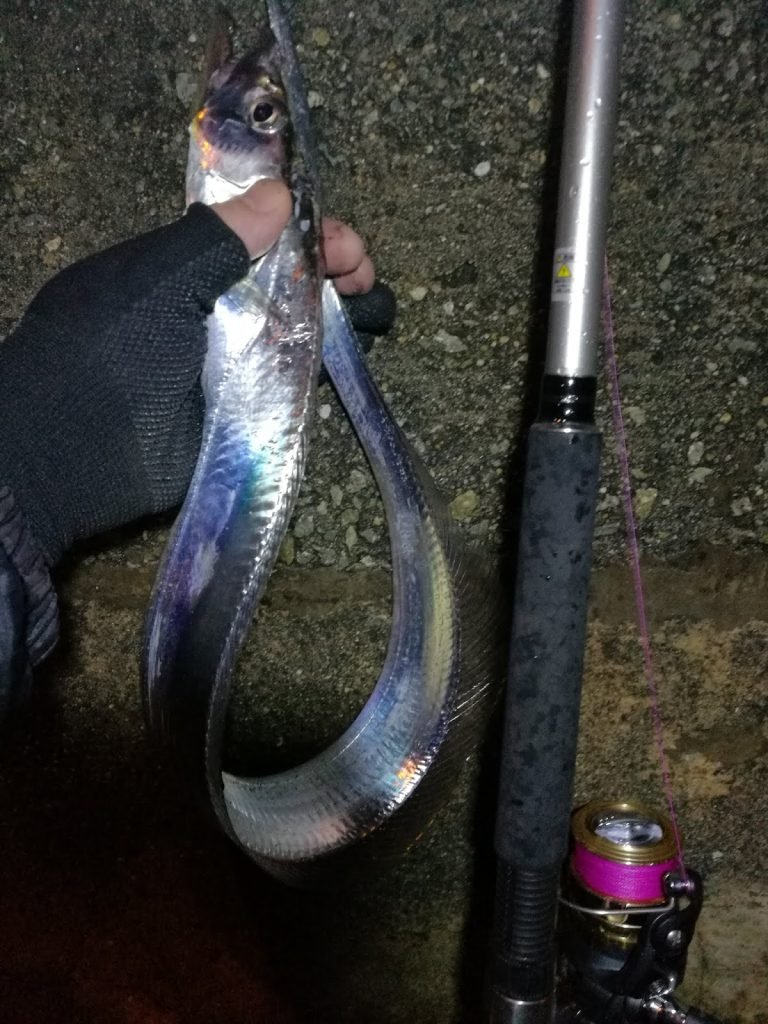
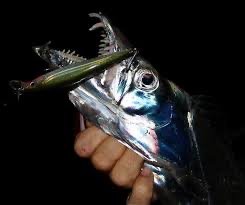
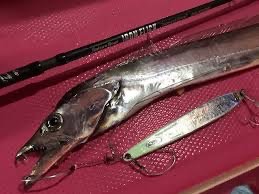
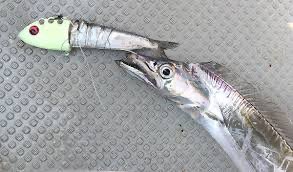
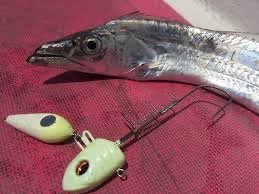

Location #3: Izumiotsu
Point #1: Shiomi Wharf / Sand Storage Ground Revetment
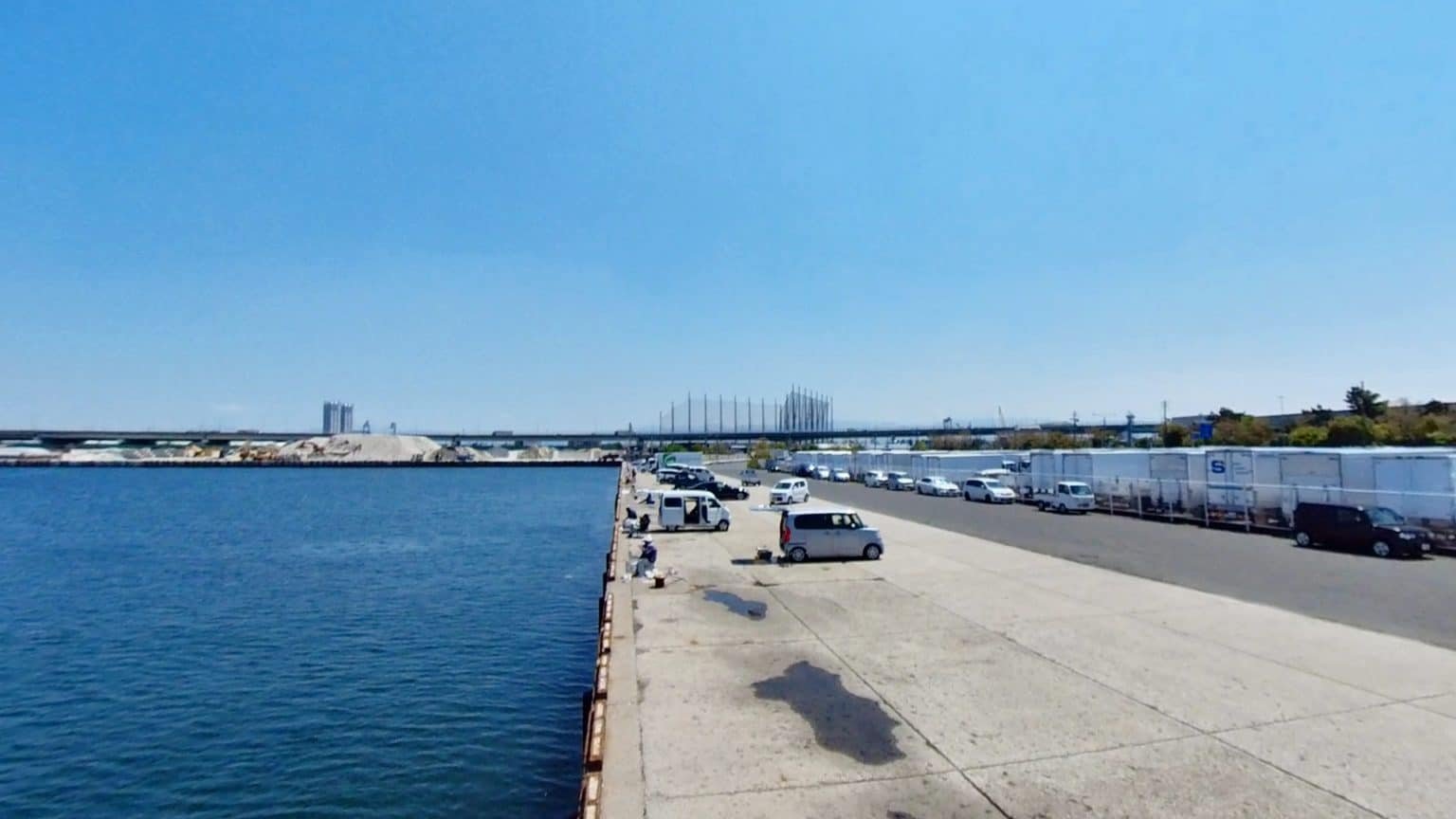
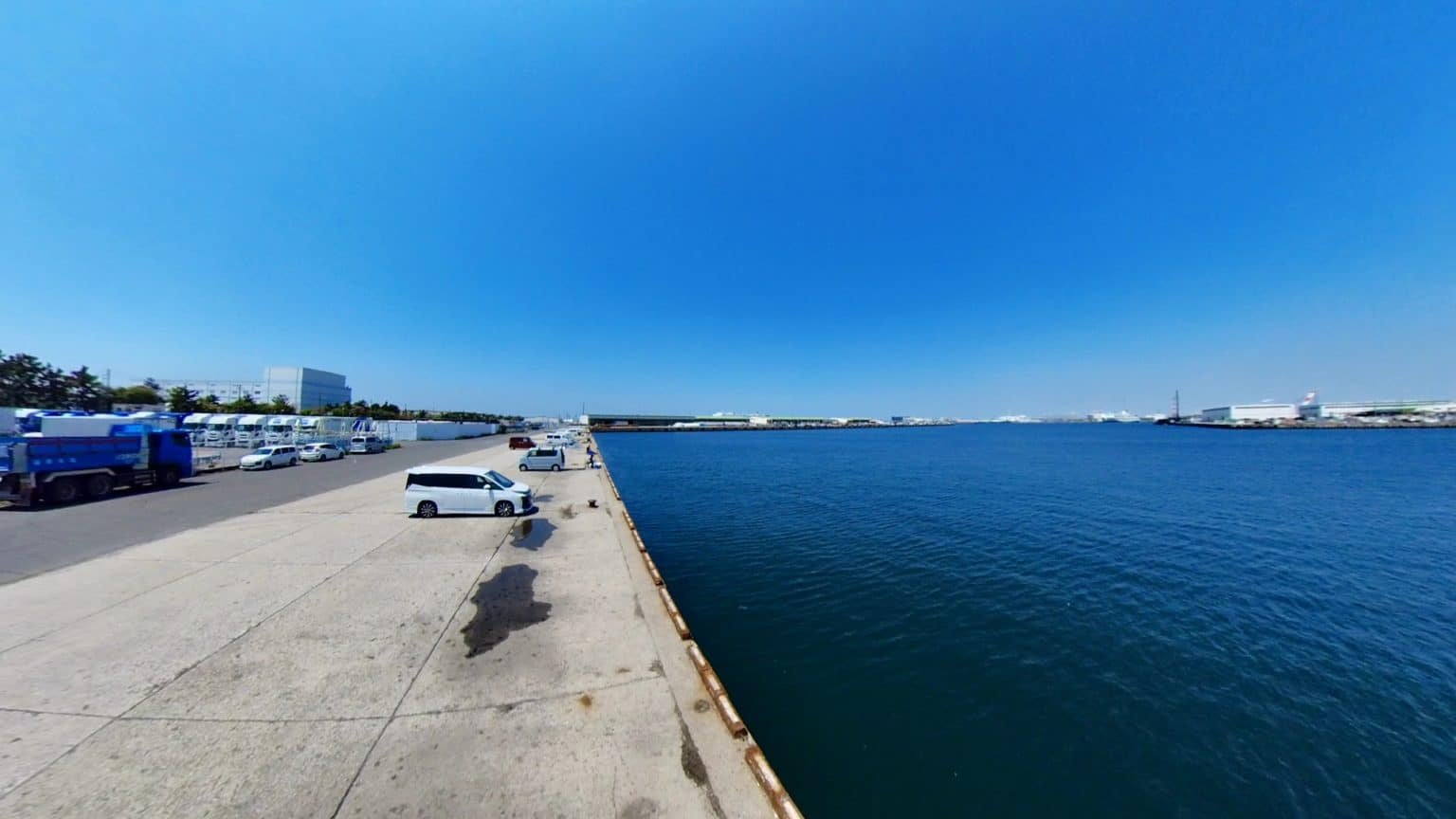
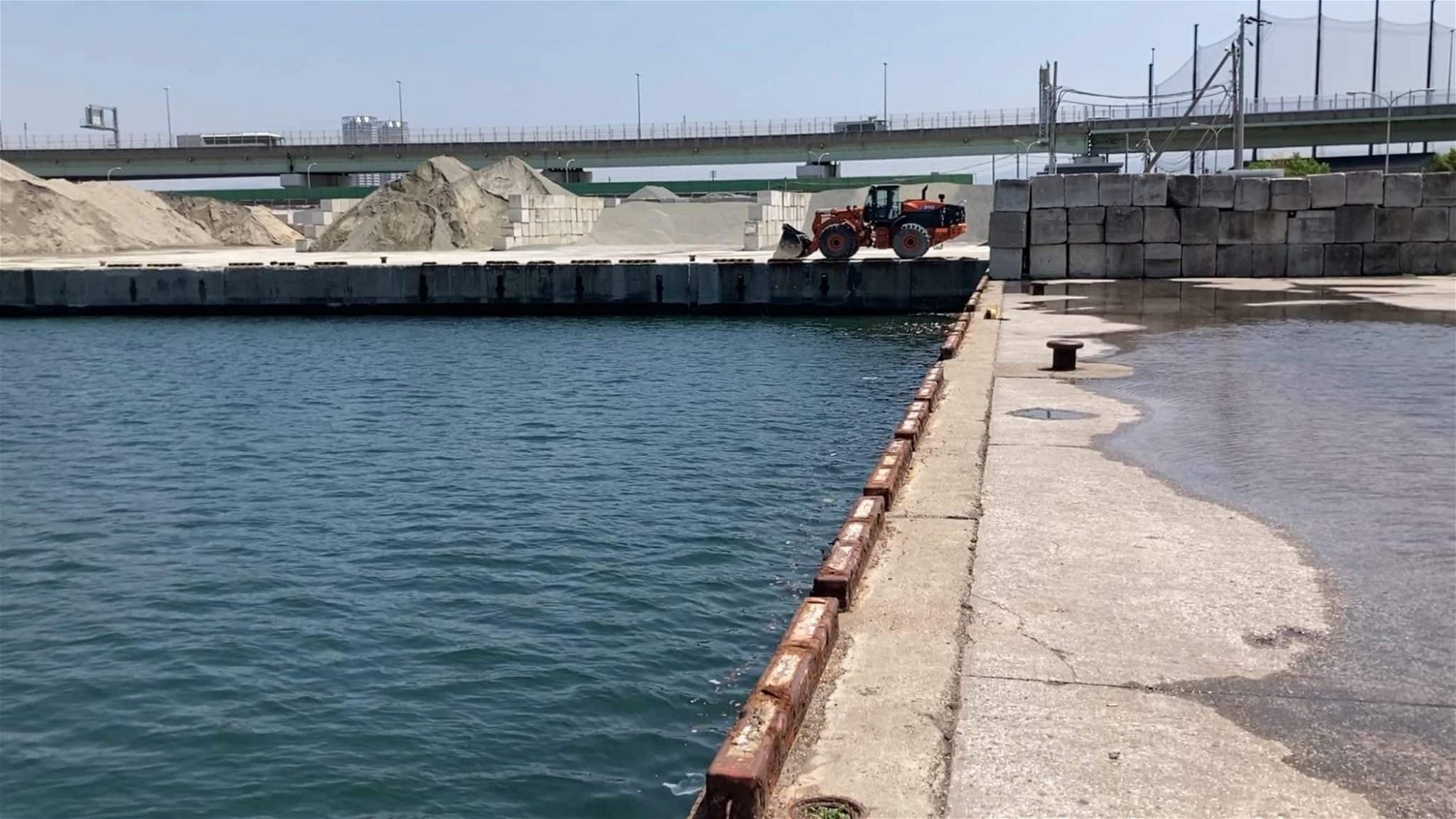
Is this enough BLUE for you? Shiomi Wharf and Sand raising storage flats are Partial public access with- get this- DRIVE UP PARKING FREE! The City of Izumiotsu built this artificial Island with its long south to north sea wall as a protection inlet that is very wide with the wharf on both the south side and the north side of the bay inlet. Access is free. There are no fences , however, it is all drive on flat revetment and therefore very easy to set up and fish. The picture above is one of those rare mornings where folks had yet to have arrived. Often it can be crowded. The fishable area runs East to West. This means that the natural shadow created by revetment walls that attracts fish is not there until after the sun has passed its apex. Therefore this is a very popular Late afternoon and evening spot! Dont go heavy on the axle and drive right into the bay. But park, unload the back of your car, have a seat and enjoy almost year round black bream and sea bass or Hane, baby sea bass at your feet!
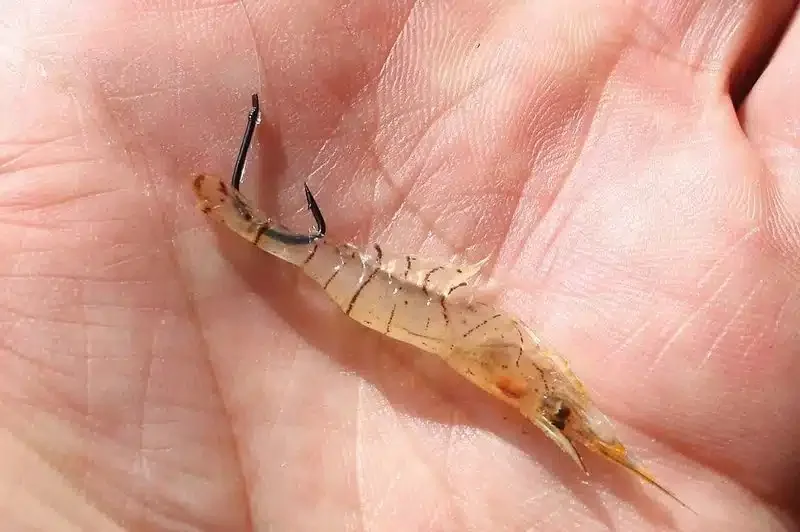
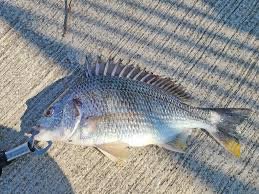
DETAILS:
The concrete flat revetment high wall is about 4m. deep at low tide, 6m. deep at high tide.
The farther eastward along the wall you move the more shallow it gets.
Surface water is 1-2m. from the revetment blacktop.
Telescopic 3 m. Net is recommend for hauling up heavy fish.
Summer though autumn, migrating horse mackerel, mackerel, sardines, and so on can be caught using the multi hook sabiki leader.
Preying cutlass fish also enter here July through December.
No toilets nor facilities. Family Mart and a Fishing Max store within 5min.drive.
Far from any station. Use bikes or a vehicle.
Good place for families/ beginner anglers! Just watch those children! NO RETAINING FENCE nor guardrails.
!!!!! Shiomi Pier road will be closed with a vehicle blocking gate from 20:00hrs to 05:00hrs. Do not get trapped inside!!!!!
Route 29/ 595-0054大阪府泉大津市汐見町106
Point #2: Nagisa Koen and Harbor area.

Another swell point worth mentioning is Nagisa Koen in Izumiotsu city. Truth be told, it not so ‘Secret’ as it has free parking, toilets, AND a BBQ area. It is quite popular. However, what IS secret, being largely unknown to the general public is, due to the gentle incoming tidal current within a LONG inlet after bay, its a GOOD spot to land Aoorika, Squid! In my younger days I would try religiously to land one of these allusive bad boys only to fail. Below is a friend and mentor’s dandy catch!
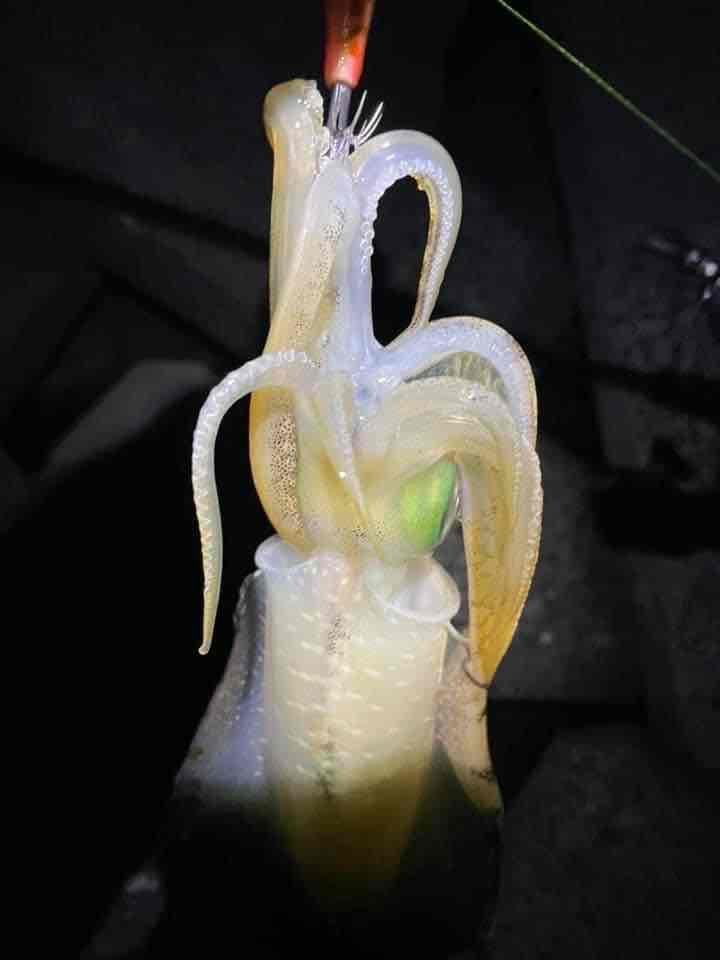
Bent on catching to eat, I would fail miserably then stop by on my way home at the fish market just to buy one to make up for my misery. Nagisa park is where I finally hooked up with my first good sized squid. Another selling point is, as it is an inland bay, Various buildings around cut the wind by half or more and local fish such as Black bream, Sea bass, Millet, Gurei, or Gisela Punctuatta, a sort of sea bass species to be found at your feet year-round.
DETAILS:
Free Parking ; Three minute walk to water.
Concrete revetment 3-5 m. Deep.
Surface water is 1-2m. from the revetment blacktop.
Telescopic 3 m. Net is recommend for hauling up heavy fish.
Summer though autumn, migrating horse mackerel, mackerel, sardines, and so on can be caught using the multi hook sabiki leader.
Toilet facilities available.
Bbq area available.
North wharf area, no fishing around the boats.
Squid comes into this inlet in both spring and fall, with fall catches being considerably bigger!
The paved revetment fishing open area has a fall prevention fence!
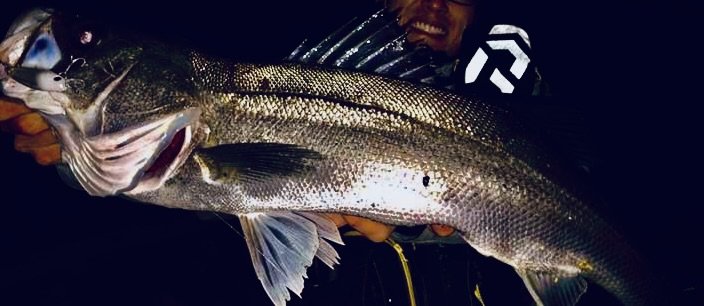
Location #4 Kishiwada -Tadaoka Port and Otsu River mouth
Point #1: Tadaoka Port/ Kishiwada Harbor
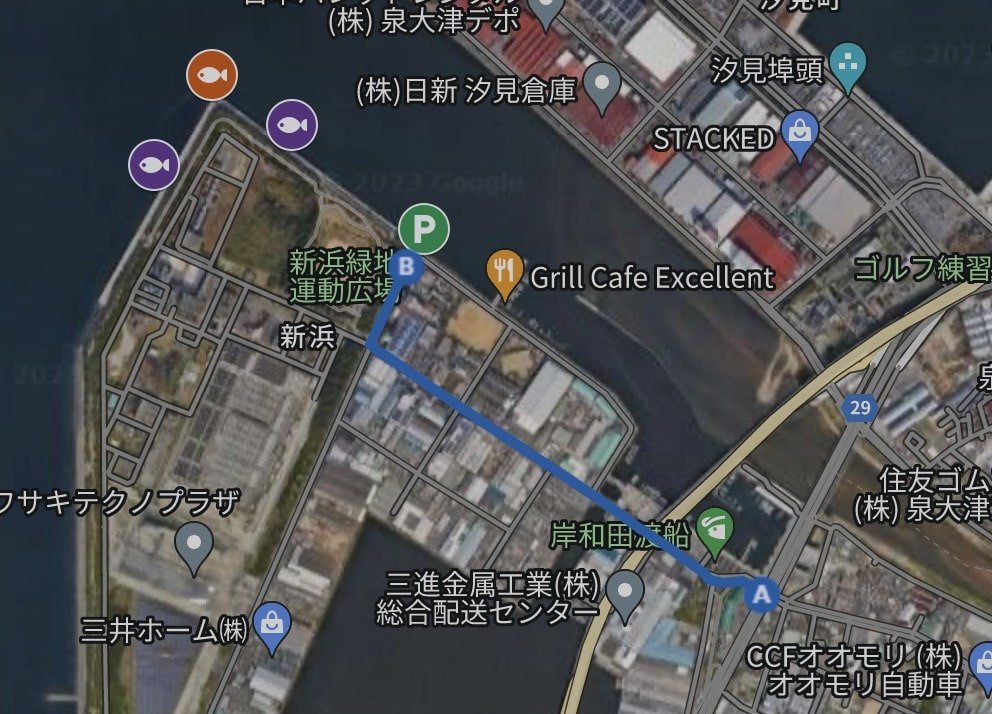
The river mouth is located under the Route 4 Kaizuka Hwy Bridge and just off of Highway 29. The small port of Tadaoka is located on a rather wide and long mouth of the Otsu River that flows between two manmade island before trailing landward. As the Highway goes across the River, the first point to access is the under bridge area for baby sea bass. I will say it now. This location teems with sea bass. Large scale bass come back to spawn, small scale bass grow here before taking to the open sea and becoming bigger. The nutrient rich mouth of the OTSU River has a good many fish that gather here. Hane is the word for underling sized sea bass, and spring time is a good time to land four or five 20- 30 cm. beauties. The fall are good times to target the same fish, now bigger into the 40-50 cm. Range. Winter to spring are times to target the bigger commuter sea bass with lures and or sardines threaded on hook-like lures.
Connected to the under bridge area and the small harbor is a thin Jetty that runs out from Tadaoka port harbor onto the bay from the river area. Water deepens the father you got out. The jetty is about 6-800 meters and is a great place to score large sea bass. In June Unagi fishers can be seen with their lights and generators.
DETAILS:
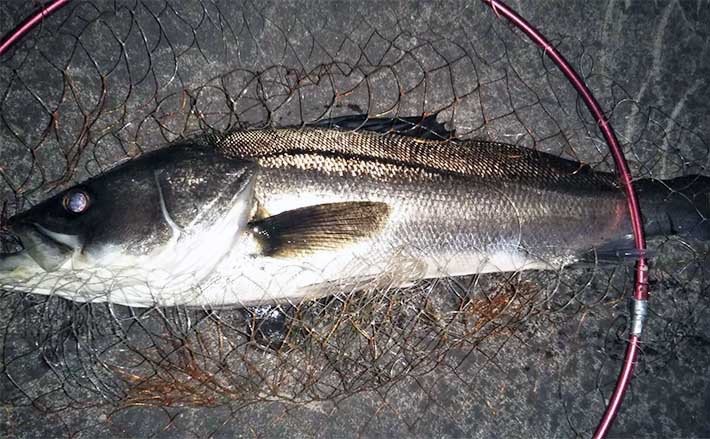
- 6-8 ft rod and top water or mid water lures are recommended.
- Break water and shallow fishing abounds.
- Access to this area is a dry dock area nearest the harbor access road.
- Tadaoka Rainwater Pumping Station is located here.
- A small underpass big enough for one car at a time exists here- park in the dry dock yard.
- Ascend a ladder on the wall that takes you to break water on the other side.
- Fish under the bridge, and along the sides of the river.
- A very thin concrete jetty also stretches for about 8oo m. from the access point.
- Drive onto the man made Island that is the MOKUZAI KOMBINAT (Lumber Mill Island).
- On its northwest side rests a Tadaoka Terrace Park and Tadaoka Terrace High Wall.
- Park outside the park on the access road for free, seek access along the fence line.
- 8-15 foot flexible carbon, fiberglass, or telescopic rod recommended.
- Bait or lure fishing is key here. Very deep water.
- A floatable fishing vest or a life preserver is HIGHLY RECOMMENDED. Wear one!
- You will likely engage LARGE fish here.
- A strong telescopic net in the 7 meter range is recommended.Private vehicle or bike a must.
- 40 cm class to one meter class sea bass can be had here.
- Thin jetty offers access to mid river area, shallow one side, deep on the harbor route side.
- Bassing net or hand gaff recommended.
- No facilities.

Point #2: Takaba


Takaba can only be reached from The sea side terrace. Once an extremely popular fishing ground, it was found that the Island Pier was too old and the main wall and terrace were closed to fishing but kept open for walkers. Before long, anglers realized that the walkway still bore access to the west side of the man made island wherein a great many coveted fish reside. Green fish, mini tuna, bream, sea bass, scorpion fish all in large sizes are abundant here. People in the know are still fishing on this side of the revetment though the walk to get there is long indeed. Net and proper gear as well as a flotation vest is recommended.

DETAILS:
- Private vehicle or bike a must.
- Surface revetment to water is three to four meters higher than water surface.
- Expect wave splash back in windy weather.
- Depth is Very deep over 13 Hiro which is about 9-12 m. deep.
- Long telescopic net necessary.
- Long walk to water, over 500m.
- 8-15 foot flexible carbon, fiberglass, or telescopic rod recommended.
- Bait or lure fishing is key here. Very deep water.
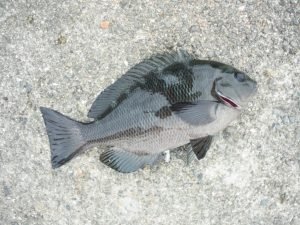
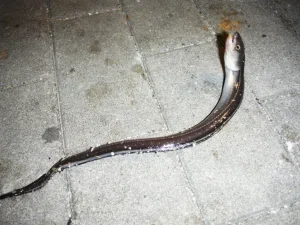
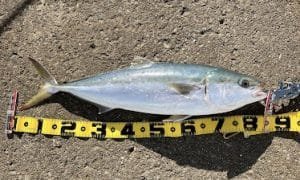
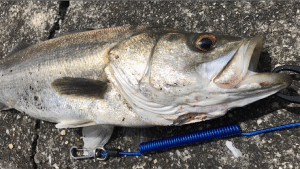
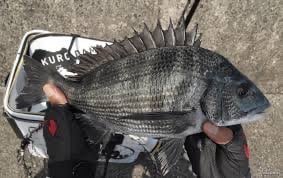

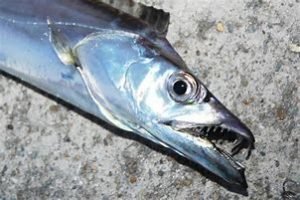
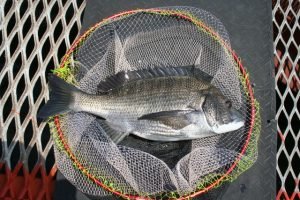
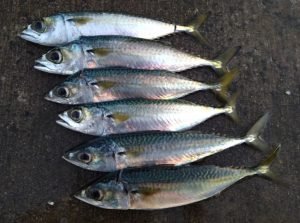
Stay tuned for part 3 of 3 which will cover the central to South Bay Area
And best fishing!! From all of us here at Osaka.com!






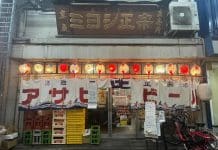



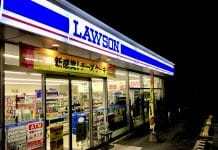











Woah, Wes!! Great piece!! I had no idea you were such a fishing expert! This is a great resource!
Thank you Sam! I appreciate it! Yes, love fishing! You’ll have to come along one time!
Cheers, Wes
Hey Wes, another amazingly detailed article! The pics are beautiful!
A tremendous amount of research must have contributed to this! Great job darlin!
Thanks so much! Awesome !You know me, I’m your fishing fool! Love you for the comments! Part Three and final comes out soon! Stay tuned! Wes